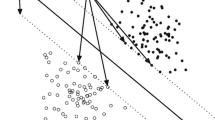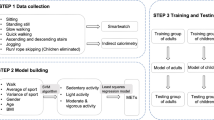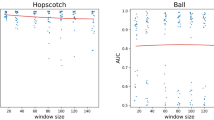Abstract
Physical activity monitoring for youth is an area of increasing scientific and public health interest due to the high prevalence of obesity and downward trend in physical activity. However, accurate assessment of such activity remains a challenging problem because of the complex nature in which certain activities are performed. In this study, we formulated the issue as a machine learning problem—using a diverse set of 19 physical activities commonly performed by youth—via two approaches: activity recognition and intensity estimation. With the aid of training data, we implemented a distance metric learning method called DML-KNN that utilizes time-frequency features and is capable of effectively classifying both continuous and intermittent movement in youth subjects. Four different time-frequency feature extraction methods were then systematically evaluated. Our results show that the DML-KNN method performed competitively, especially when using features extracted by the Tamura method for intensity estimation, and by the Square Coefficient method for activity recognition.








Similar content being viewed by others
Explore related subjects
Discover the latest articles, news and stories from top researchers in related subjects.References
Allen FR, Ambikairajah E, Lovell NH, Celler BG (2006) Classification of a known sequence of motions and postures from accelerometry data using adapted gaussian mixture models. Physiol Meas 27(10):935
Aminian K, Najafi B (2004) Capturing human motion using body-fixed sensors: outdoor measurement and clinical applications. Comput Anim Virtual Worlds 15(2):79–94
Awais M, Mellone S, Chiari L (2015) Physical activity classification meets daily life: review on existing methodologies and open challenges. In: 2015 37th Annual International Conference of the IEEE Engineering in Medicine and Biology Society (EMBC). IEEE, pp 5050–5053
Bao L, Intille SS (2004) Activity recognition from user-annotated acceleration data. In: Pervasive computing. Springer, Berlin Heidelberg New York, pp 1–17
Cleland I, Kikhia B, Nugent C, Boytsov A, Hallberg J, Synnes K, McClean S, Finlay D (2013) Optimal placement of accelerometers for the detection of everyday activities. Sensors 13(7):9183–9200
Crouter SE, Clowers KG, Bassett DR (2006) A novel method for using accelerometer data to predict energy expenditure. J Appl Physiol 100(4):1324–1331
Crouter SE, Horton M, Bassett DR Jr (2012) Use of a 2-regression model for estimating energy expenditure in children. Med Sci Sports Exerc 44(6):1177
Dalton A, OLaighin G (2013) Comparing supervised learning techniques on the task of physical activity recognition. IEEE J Biomed Health Inform 17(1):46–52
Ellis K, Kerr J, Godbole S, Lanckriet G, Wing D, Marshall S (2014) A random forest classifier for the prediction of energy expenditure and type of physical activity from wrist and hip accelerometers. Physiol Meas 35(11):2191
Ermes M, Parkka J, Mantyjarvi J, Korhonen I (2008) Detection of daily activities and sports with wearable sensors in controlled and uncontrolled conditions. IEEE Trans Inf Technol Biomed 12(1):20–26
Freedson PS, Lyden K, Kozey-Keadle S, Staudenmayer J (2011) Evaluation of artificial neural network algorithms for predicting mets and activity type from accelerometer data: validation on an independent sample. J Appl Physiol 111(6):1804–1812
Hong YJ, Kim IJ, Ahn SC, Kim HG (2010) Mobile health monitoring system based on activity recognition using accelerometer. Simul Model Pract Theory 18(4):446–455
Khan AM, Lee YK, Lee SY, Kim TS (2010) A triaxial accelerometer-based physical-activity recognition via augmented-signal features and a hierarchical recognizer. IEEE Trans Inf Technol Biomed 14(5):1166–1172
Lovell N, Wang N, Ambikairajah E, Celler BG (2007) Accelerometry based classification of walking patterns using time-frequency analysis. In: 29th Annual International Conference of the IEEE Engineering in Medicine and Biology Society, 2007. EMBS 2007. IEEE, pp 899–4902
Mannini A, Intille SS, Rosenberger M, Sabatini AM, Haskell W (2013) Activity recognition using a single accelerometer placed at the wrist or ankle. Med Sci Sports Exerc 45(11):2193–2203
Mathie M, Celler BG, Lovell NH, Coster A (2004) Classification of basic daily movements using a triaxial accelerometer. Med Biol Eng Comput 42(5):679–687
Mu Y, Ding W, Tao D (2013) Local discriminative distance metrics ensemble learning. Pattern Recogn 46(8):2337– 2349
Mu Y, Lo HZ, Ding W, Tao D (2014) Face Recognition from Multiple Images per subject. In: Proceedings of the ACM International Conference on Multimedia. ACM, pp 889–892
Mu Y, Lo HZ, Ding W, Amaral K, Crouter SE (2014) Bipart: learning block structure for activity detection. IEEE Trans Knowl Data Eng 26(10):2397–2409
Najafi B, Aminian K, Loew F, Blanc Y, Robert P et al (2002) Measurement of stand-sit and sit-stand transitions using a miniature gyroscope and its application in fall risk evaluation in the elderly. IEEE Trans Biomed Eng 49(8):843–851
Nguyen TT, Liew AWC, Tran MT, Nguyen MP (2014) Combining multi classifiers based on a genetic algorithm–a gaussian mixture model framework. In: Intelligent Computing Methodologies. Springer, Berlin Heidelberg New York, pp 56–67
Nyan M, Tay F, Seah K, Sitoh Y (2006) Classification of gait patterns in the time–frequency domain. J Biomech 39(14):2647–2656
Pärkkä J, Ermes M, Korpipää P, Mäntyjärvi J, Peltola J, Korhonen I (2006) Activity classification using realistic data from wearable sensors. IEEE Trans Inf Technol Biomed 10(1):119–128
Parkka J, Ermes M, Antila K, van Gils M, Manttari A, Nieminen H (2007) Estimating intensity of physical activity: a comparison of wearable accelerometer and gyro sensors and 3 sensor locations. In: 29th Annual International Conference of the IEEE Engineering in Medicine and Biology Society, 2007. EMBS 2007. IEEE, pp 1511–1514
Pober DM, Staudenmayer J, Raphael C, Freedson PS et al (2006) Development of novel techniques to classify physical activity mode using accelerometers. Med Sci Sports Exerc 38 (9):1626
Preece SJ, Goulermas JY, Kenney LP, Howard D (2009) A comparison of feature extraction methods for the classification of dynamic activities from accelerometer data. IEEE Trans Biomed Eng 56(3):871–879
Preece SJ, Goulermas JY, Kenney LP, Howard D, Meijer K, Crompton R (2009) Activity identification using body-mounted sensors—a review of classification techniques. Physiol Meas 30(4):R1
Reiss A, Stricker D (2011) Introducing a modular activity monitoring system. In: 2011 Annual International Conference of the IEEE Engineering in medicine and biology society, EMBC. IEEE, pp 5621–5624
Sekine M, Tamura T, Togawa T, Fukui Y (2000) Classification of waist-acceleration signals in a continuous walking record. Med Eng Phys 22(4):285–291
Sekine M, Tamura T, Akay M, Fujimoto T, Togawa T, Fukui Y (2002) Discrimination of walking patterns using wavelet-based fractal analysis. IEEE Trans Neural Syst Rehabil Eng 10(3):188–196
Skotte J, Korshøj M, Kristiansen J, Hanisch C, Holtermann A (2014) Detection of physical activity types using triaxial accelerometers. J Phys Act Health 11(1):76–84
Staudenmayer J, Pober D, Crouter S, Bassett D, Freedson P (2009) An artificial neural network to estimate physical activity energy expenditure and identify physical activity type from an accelerometer. J Appl Physiol 107(4):1300–1307
Troiano RP, McClain JJ, Brychta RJ, Chen KY (2014) Evolution of accelerometer methods for physical activity research. Br J Sports Med 48(13):1019–1023
Trost SG, Wong WK, Pfeiffer KA, Zheng Y (2012) Artificial neural networks to predict activity type and energy expenditure in youth. Med Sci Sports Exerc 44(9):1801
Trost SG, Zheng Y, Wong WK (2014) Machine learning for activity recognition: hip versus wrist data. Physiol Meas 35(11): 2183
Veltink PH, Bussmann HB, De Vries W, Martens WL, Van Lummel RC (1996) Detection of static and dynamic activities using uniaxial accelerometers. IEEE Trans Rehabil Eng 4(4):375–385
Yi C, Jeong S, Han KS, Lee H (2013) Age-group classification for family members using multi-layered bayesian classifier with gaussian mixture model. In: Multimedia and Ubiquitous Engineering. Springer, Berlin Heidelberg New York, pp 1153–1159
Zhou Y, Cheng Z, Jing L, Hasegawa T (2015) Towards unobtrusive detection and realistic attribute analysis of daily activity sequences using a finger-worn device. Appl Intell 43(2): 386–396
Zijlstra W, Aminian K (2007) Mobility assessment in older people: new possibilities and challenges. Eur J Ageing 4(1):3–12
Acknowledgments
This study was supported by a grant from National Institutes of Health (R21HL093407) to develop novel approaches to monitor physical activity in children.
Author information
Authors and Affiliations
Corresponding authors
Rights and permissions
About this article
Cite this article
Ren, X., Ding, W., Crouter, S.E. et al. Activity recognition and intensity estimation in youth from accelerometer data aided by machine learning. Appl Intell 45, 512–529 (2016). https://doi.org/10.1007/s10489-016-0773-3
Published:
Issue Date:
DOI: https://doi.org/10.1007/s10489-016-0773-3




